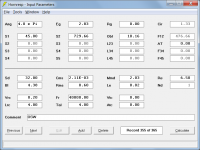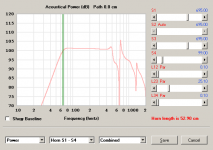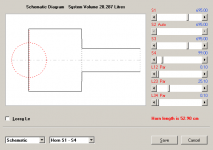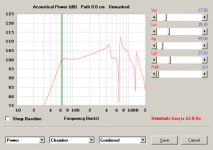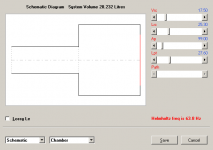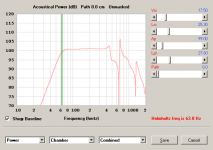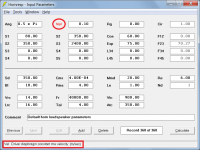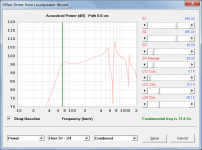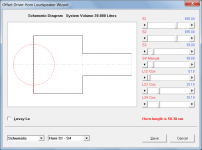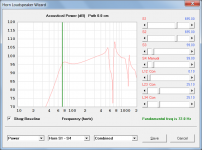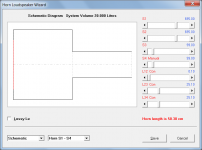I suspect that it would not even be possible to run a MMM simulation of 500 frequencies and 32 modes on my computer, let alone worrying about the time that it might take 🙂.
(My PC has an AMD E-450 processor and 2 GB RAM, of which only 1.6 GB is usable).
I think you would be fine with that computer. MMM doesn't need a lot of memory, and it is not necessary to run anything in parallel. You may have to wait a couple of minutes for the results, though 🙂
You may have to wait a couple of minutes for the results, though 🙂
A bit longer than a couple of minutes, I suspect 🙂. Producing the normalised polar map for Fred's OSW design example using the relatively simple model in Hornresp took 8 minutes and 10 seconds on my computer. Nevertheless, it would be interesting to try - if only I had the coded MMM algorithms... 🙂.
Attachments
Hello David,
8 Minutes seems very long - on my years old i5 Intel NUC it took 41 seconds, while hornresp is using only 25% of the CPU. It´s a 2 core machine with hyperthreading (=4 virtual cores).
Seems hornresp only picks up one virtual core.
On an old Pentium 4 (my CAD/CAM Machine) with P4-630 (single core, 2 threads, 3Ghz), it took 70 seconds.
One "core" is used again.
So I assume hornresp is "single thread software".
Investigating further :
Comparing your AMD CPU to my very old P4 on single thread performance with passmark:
PassMark - CPU Comparison AMD E-450 APU vs Intel Pentium 4 3.00GHz
Your CPU: 430 Points
P4 3Ghz: 650 Points
(singe thread performance on a midclass-modern cpu is around 2000 for a 150$ CPU)
Even with your CPU a little slower on single thread performance than a 10 year old P4 - you should be able to get computing times much lower than two minutes - since hornresp isn´t using many very modern CPU-capabilities like AVX, raw single thread performance from passmark should give a rough estimate..
What is happening here? Am I missing something and doing the wrong comparison? Somehow your system seems even slower when calculating polar response than my pentium 3..
8 Minutes seems very long - on my years old i5 Intel NUC it took 41 seconds, while hornresp is using only 25% of the CPU. It´s a 2 core machine with hyperthreading (=4 virtual cores).
Seems hornresp only picks up one virtual core.
On an old Pentium 4 (my CAD/CAM Machine) with P4-630 (single core, 2 threads, 3Ghz), it took 70 seconds.
One "core" is used again.
So I assume hornresp is "single thread software".
Investigating further :
Comparing your AMD CPU to my very old P4 on single thread performance with passmark:
PassMark - CPU Comparison AMD E-450 APU vs Intel Pentium 4 3.00GHz
Your CPU: 430 Points
P4 3Ghz: 650 Points
(singe thread performance on a midclass-modern cpu is around 2000 for a 150$ CPU)
Even with your CPU a little slower on single thread performance than a 10 year old P4 - you should be able to get computing times much lower than two minutes - since hornresp isn´t using many very modern CPU-capabilities like AVX, raw single thread performance from passmark should give a rough estimate..
What is happening here? Am I missing something and doing the wrong comparison? Somehow your system seems even slower when calculating polar response than my pentium 3..
Hi Sabbelbacke,
Thanks for investigating this issue.
Did you use the same OSW design example as me? See attachment.
Calculation times vary considerably depending upon the flare profile of the horn. In my case, changing from Obl to Exp reduces the time it takes to produce the polar map down to 72 seconds. Were you using an exponential flare in your example, perhaps?
Kind regards,
David
Thanks for investigating this issue.
on my years old i5 Intel NUC it took 41 seconds
Did you use the same OSW design example as me? See attachment.
On an old Pentium 4 (my CAD/CAM Machine) with P4-630 (single core, 2 threads, 3Ghz), it took 70 seconds.
Calculation times vary considerably depending upon the flare profile of the horn. In my case, changing from Obl to Exp reduces the time it takes to produce the polar map down to 72 seconds. Were you using an exponential flare in your example, perhaps?
Kind regards,
David
Attachments
I get 2:04 to calculate a polar map on an I-7-4770 32GB of RAM.
So the question is if Bjørn is interested in trying to incorporate his method into Hornresp. Bjørn I don't remember that option when I was fooling around with HornCAD!
So the question is if Bjørn is interested in trying to incorporate his method into Hornresp. Bjørn I don't remember that option when I was fooling around with HornCAD!
I can see now that what I really need is a quantum computer, or a Cray supercomputer at the very least!
Hi David,
AMD is making a comeback of sorts this year, new CPU's with very high performance per dollar will be available.
The rumor mill has it this way at the moment:
Code:
AMD Ryzen CPU Cores/Threads Base Clock Boost Clock TDP Price Debut
Ryzen 3 3300 6/12 3.2GHz 4.0GHz 50W $99 CES
Ryzen 3 3300X 6/12 3.5GHz 4.3GHz 65W $129 CES
Ryzen 3 3300G 6/12 3.0GHz 3.8GHz 65W $129 Q3 2019
Ryzen 5 3600 8/16 3.6GHz 4.4GHz 65W $178 CES
Ryzen 5 3600X 8/16 4.0GHz 4.8GHz 95W $229 CES
Ryzen 5 3600G 8/16 3.2GHz 4.0GHz 95W $199 Q3 2019
Ryzen 7 3700 12/24 3.8GHz 4.6GHz 95W $299 CES
Ryzen 7 3700X 12/24 4.2GHz 5.0GHz 105W $329 CES
Ryzen 9 3800X 16/32 3.9GHz 4.7GHz 125W $449 CES
Ryzen 9 3850X 16/32 TBA TBA 135W $499 TBASo the question is if Bjørn is interested in trying to incorporate his method into Hornresp. Bjørn I don't remember that option when I was fooling around with HornCAD!
A lot has happened with HornCAD since then. Still many loose ends to tie up, but I hope that some day it will be available to a wider public. But first I have a book to finish 🙂
A lot has happened with HornCAD since then. Still many loose ends to tie up, but I hope that some day it will be available to a wider public. But first I have a book to finish 🙂
I'll be on the buy list. I have enjoyed your articles up to know.
As for software I know the time it takes. We are doing in house one stop simulation from magnetics to soft parts and it is taking quite some time to complete. But what we are getting accomplished is definitely worth the effort.
Hi ! Got again a idea, sorry... I don't know if it is doable, but as I see it would be interesting simulating enclosures, whatever the topology, with a perfect speaker. I don't know how to make so that pressure at speaker entry is simed perfect. But this should allow to extract response, phase, group delay only dues to enclosure only. Going farther, substracting this response to a full system response with it driver, we get so driver effect (cone mass low pass can be so seen for exemple). And the enclosure response in itself should allow to create harmonics distortion reduction curves. Isn't it challenging ?
Hi,
i've simulated the same driver as mlqw and as br with same dimensions, the only difference i'm aware is that the br has(probably?) a round port. Why is the frequency responce that much diffrent?
Thanks in advance, Johannes
i've simulated the same driver as mlqw and as br with same dimensions, the only difference i'm aware is that the br has(probably?) a round port. Why is the frequency responce that much diffrent?
Thanks in advance, Johannes
Attachments
i've simulated the same driver
Sorry, i had a mistake with the driver values, so now the response seems pretty equal.
So, a(straight) mlqw is the same as a br?
Here Bob Brines argues it is not: Quarter Wave Pipes are NOT Bass Reflex
Can someone enlight me?
Attachments
it would be interesting simulating enclosures, whatever the topology, with a perfect speaker.
Hi Damien,
This can already be done, using the driver diaphragm constant velocity option.
Kind regards,
David
Attachments
so now the response seems pretty equal.
Hi Johannes,
The results will become identical if you specify the "bass-reflex" system using a horn segment for the port rather than Ap and Lpt. This is because a port specified using Ap and Lpt includes an internal end correction, which is not present in the offset driver system being used in your comparison.
Whatever you choose to call them, your two example systems are for all practical purposes the same.
Kind regards,
David
Attachments
Whatever you choose to call them, your two example systems are for all practical purposes the same.
Thank you very much, this is a demystifying moment for me ;-)
Wow ! It's really fun to play with ! And results are somewhat surprising, speakers damps a looooot more than what i would was thought.Hi Damien,
This can already be done, using the driver diaphragm constant velocity option.
Kind regards,
David
When Vel is selected, is it normal that only diaphragm excursion and acoustical power screens changes ?
Whereas importing both Eg/Vel impulse in REW, i don't get same group delay curves, as expected. I probably miss something, again, sorry...

So, a(straight) mlqw is the same as a br?
Depends on the aspect ratio, which once high enough will impact Fb [lower tuning for a given vent alignment] just as BB explained/proved with measurements.
A simple way to view it is that the vent length decreases with increasing cab/pipe aspect ratio.
Consider a woofer with a low Fs, Qts, Vas, high power handling, which can wind up with a TL size vent attached to a small box once a low vent mach is factored in, so why not morph it into an inverse tapered TQWT and get a bit of extra driver damping due to a 1/4 WL fundamental without as much loss in efficiency than if damping the BR's vent to quell its 1/2 WL pipe harmonics?
GM
When Vel is selected, is it normal that only diaphragm excursion and acoustical power screens changes ?
Hi Damien,
In effect all that happens when Vel is selected is that Eg varies with frequency to maintain a constant diaphragm velocity. This is why only the acoustical power and diaphragm displacement results change.
Kind regards,
David
Hello David,Calculation times vary considerably depending upon the flare profile of the horn..... Were you using an exponential flare in your example, perhaps?
indeed, that cleared things up. I am now at 4:25 calculating time for your given example on my i5-4250u.
One thing is interesting: I have 2 Cores with hyperthreading enabled (=4 cores) - hornresp seems to use only one of the 4 virtual cores - I never get above 25% for the hornresp instance.
Do you see any chance to enable multiple threads in hornresp? On modern CPUs with many cores, this could speed up things quite a bit.
Kind regards,
Sabbelbacke
Hi,Hi Damien,
In effect all that happens when Vel is selected is that Eg varies with frequency to maintain a constant diaphragm velocity. This is why only the acoustical power and diaphragm displacement results change.
Kind regards,
David
I'll have to look closer...and do my homeworks

 . I don't get why exported impulses from Eg and Vel did not give me the same group delay curves when imported in REW, but did in hornresp... 😕
. I don't get why exported impulses from Eg and Vel did not give me the same group delay curves when imported in REW, but did in hornresp... 😕Depends on the aspect ratio, which once high enough will impact Fb [lower tuning for a given vent alignment] just as BB explained/proved with measurements.
A simple way to view it is that the vent length decreases with increasing cab/pipe aspect ratio.
I don't understand. Which aspect ratio, vent_lengh : pipe_length? high aspect ratio means 1:10 is higher than 1:5? The higher the more mlqw and less br?
- Home
- Loudspeakers
- Subwoofers
- Hornresp

